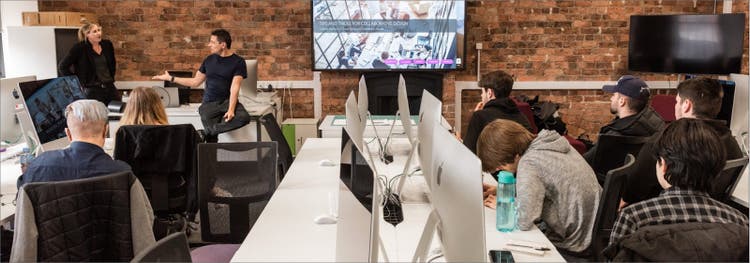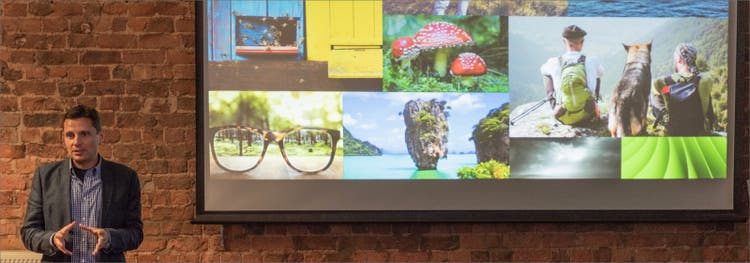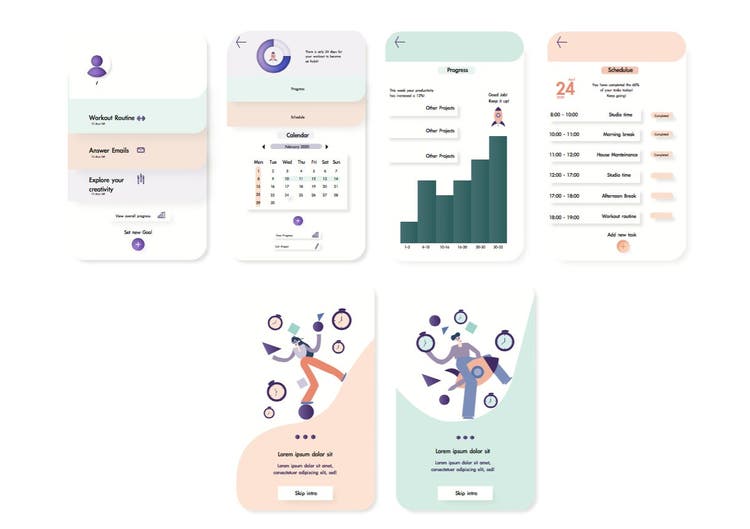How Liverpool Hope University Gives Its Graphic Design Students a Head Start

Adobe Stock / Stockwerk-Fotodesign
The world of creativity is ever changing and extremely fast-moving.
To get a foot in the door of a creative career and stand out from the competition, students these days need to familiarize themselves with more than traditional graphic design skills. Design schools therefore increasingly equip their students with cutting-edge technology and innovative workflows to give them a head start in the industry. One institution leading the field is Liverpool Hope University in the North West of the UK. Its new specialist graphic design BA course ensures students apply the theoretical knowledge they’ve learned hands-on by giving them access to design and collaboration tools – both industry-standards and brand new ones.
Working closely with Adobe, the undergraduates benefit from practical on-campus events that introduce them to software, trends, and industry best practices.
“Having up-to-date input from the industry helps to align our students with the professions they wish to enter,” explains Mark Wood, senior professional tutor and programme leader in graphic design at the university. “This is paramount to preparing them for the world of work.” An Emerging Creative Talent event, held last year, for example, covered best practices for design, while also demystifying video creation and how to deliver content velocity (i.e. producing content efficiently at speed).

Adobe’s Emerging Creative Talent event at Liverpool Hope included a talk on tips and tricks for collaborative design presented by Celeste Menich, cloud solutions consultant at Adobe.
Empowering students with cutting-edge technology
Among other things, at the Emerging Talent event students learned how to streamline conventional workflows with shared assets and automated services and got a chance to hear about Adobe’s Premiere Rush smart device-based video editing tool, ideal for on the go editing and delivery to multiple channels. While some students had already been expanding their skill set to include video editing with Adobe Premiere or adding motion graphics with Adobe After Effects – for many, video was not part of their daily workflow yet – hence Premiere Rush represented a much more approachable starting point.
“It was really good to see how Adobe Premier Rush offers the simplicity of ‘shoot, edit and upload’ all from one device and how saving files to the Adobe Creative Cloud gives the facility the ability to shift between mobile and desktop with ease,” says Francis Vose, Senior Professional Tutor in Visual Practice at Liverpool Hope University.
“Rush removes some of the high skill requirements from video creation,” Mark adds. “The AI-assisted ‘Auto-duck’ feature in particular will save us hours in the editing room in order to drop down the volume of backing tracks on videos to avoid audio ‘clash’ when several people are talking.”
Following the event, students created a 60-second documentary each using Rush. They learned that you can get content made that you can share with a client, maybe to document a larger project, without the need of a full-suite of tools. Being able to add pre-built, editable animations from Adobe Stock’s ever increasing Motion Graphics Templates selection was really seen to add the professional final touches to their productions.
Another tool students were introduced to is Adobe Dimension for 3D rendering and design. “I wasn’t aware of it before,” says student Tom Williams. “I’ve since played around with it to create some simple mockups and compared to other 3D software, I found it extremely easy to use. You can even import Blender 3D models you’ve made yourself.”
In order to aid what we at Adobe refer to as “content velocity”– the speed with which new content can be produced – the direct integration of Adobe Stock, which allows the students (and commercial users alike) to take pre-built 3D models and incorporate them into a virtual landscape, even overlaying a real photo as a backdrop, has been broadly received as a seismic step forward in enabling product photoshoots to happen without the need for creatives to go anywhere near a studio for product shots.
During the event, we also highlighted how AI is being integrated into the creative workflows to help faster search and surfacing of appropriate content for design projects…We were pleasantly surprised to learn the students were already producing work that incorporated what we were showing.

Content velocity discussion presented by Richard West, strategic development manager for Adobe Stock in EMEA.
Getting practical experience of working in the creative industry
Even during the COVID-19 lockdown, three graphic design second year students – Tom Williams, Connor Brennan, and Nik Xypakis – managed to develop their skills further and took part in an Adobe Creative Jam, co-sponsored by Airbnb, which attracted more than 450 teams. The task was to design and prototype an app using Adobe XD (here’s the finished project). As most of the other students were based across the U.S. and Canada, the Liverpool Hope undergraduates needed to work harder… an introduction to the pressures of working in a global market.
“It was a bit of a shock to get ‘midday’ briefings in the early evening,” Connor points out. “The teams in the U.S. and Canada had their afternoons and evenings to get things done but for us it meant we had to work into the small hours to hit the deadlines.”
Mark highlights the importance of such events as a way to show them what’s required from a graphic designer in the industry and how important it is to stay up to date with both trends and the software that’s available.
“Events are really valuable because students get used to me or another member of staff telling them how things are,” he says. “If they go to an event or a work placement, they find that the studio culture, the conversations, the deadlines, and the working processes are all the same as they are in the studio at the university. It gives them confidence that their learning experience is the right one.”
The way students work is very close to creative industry practice. They learn how to communicate remotely – lockdown or not – and use advanced integrated workflows, which is how they’d have to collaborate with clients.
Artwork created by Mark Wood to demonstrate the process and arresting nature of cinemagraphs. Students were tasked to choose a video from Adobe Stock, select an appropriate frame to freeze as a still layer over a video loop. Source: Adobe Stock / Puzuri
Keeping up with the latest technology
Liverpool Hope is clearly ahead of the game. Students adopt new tools and resources such as Adobe XD, Adobe Spark, Adobe Capture and Adobe Stock and use them on a day-by-day basis, while it has taken the COVID-19 lockdown for many industry players to look into them. Professional businesses often stick to their established tools and workflows just because they’re too busy getting their projects done, without realizing how much they could benefit from new tools.
“Time is precious, and people tend to do what they’ve always done,” Mark says. “When I first started teaching in higher education, in the mid-90s, I was the youngest person in the room. There were paste-up artists, who knew how to use Letraset® and light boxes, but they didn’t know what a mouse was. I said to myself that I never wanted to become redundant because I didn’t keep up with technology.”
The course isn’t prescriptive about what graphic design includes, and some student’s work straddles disciplines. One student, Danny Reposar, for example, plays in a band that’s just recorded its debut album, while other students have already been working on paid freelance projects.
“It’s absolutely essential students work with Illustrator, Photoshop, and InDesign,” Mark explains. “But they also need to understand that they are only part of the modern game, and some courses are still very fixed on the venerable apps.”

Liverpool Hope student Olga Lopez created a prototype of a time management app with Adobe XD as part of her coursework.
Students at Liverpool Hope learn about the importance of fast turnarounds, working through the night to deal with different time zones and meet tight deadlines, as well as the cost of running a business. As they already use new technology as a solution to a problem, they will be much more comfortable experimenting with and adopting new tools in the future. By bringing these skills with them as they enter the job market, they will not only push themselves forward but also the industry as a whole.
For the next year of the course Mark is planning to incorporate Adobe Aero to build immersive and interactive AR experiences. He highlights, “There’s always something new to add, and the more the students keep up with the latest developments, the more empowered they will be for the fast-moving creative industry.”
One key area Mark is keen to emphasise to his students is that, much as it may seem common place for people to take images, videos, and other assets found on the internet without the need to gain permission, give credit or recompense the creators, this is very much not the route budding creative professionals should be following.
“Given that many of these talented students may well become the next generation of artists and creators whose work is pilfered from the net without their approval, it’s great to be able to point to a resource like Adobe Stock,” he points out. “As a royalty-free image library it brings double the benefits of older fashioned contemporaries in the stock footage market by not only providing content that students and professionals alike can license and incorporate into their projects and campaigns worry free of litigation, but also provides a boost in productivity due to its integration directly into all the key Creative Cloud applications. Adobe Stock could also present the first opportunity for many of the students to publish their work worldwide and start deriving an income from their creative skills. Professional development has to be a core aspiration for any educational establishment – it’s great to actually see alumni establish a rewarding career based on the tuition given them.”